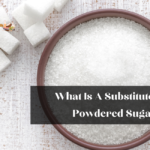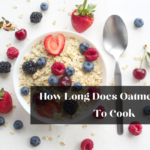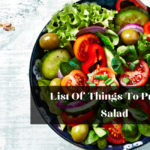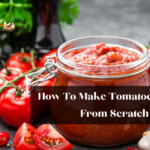Common salad ingredients include lettuce or mixed greens, garnishes, and a dressing. Salads can be a staple of a healthy diet due to the broad variety of ingredients that can be added. Some salad toppings are more nutritious than others. This article, explain list of things to put in a salad.
List Of Things To Put In A Salad
Salads are highly adaptable and can be customized to suit your tastes. Here are the 11 healthiest salad toppings.
1. Chops Of Raw Vegetables
Common salad components include lettuce, spinach, kale, arugula, and mixed greens. Nonetheless, additional fresh vegetables may be incorporated if desired.
The most popular fresh vegetable embellishments include carrots, onions, cucumbers, celery, mushrooms, and broccoli. These vegetables are abundant in dietary fiber and plant compounds with health benefits.
2. Nuts And Seeds
Salad garnishes rich in nutrients include pistachios, walnuts, pumpkin seeds, almonds, peanuts, and chia seeds.
For instance, 1 ounce (28 grams) of pumpkin seeds has 5 grams of protein and almost 20% of zinc. Also, adding 22 nuts (1 ounce or 28 grams) to a salad gives you more than 3 grams of fiber, vitamins, and minerals.
Look for fresh or dry-roasted nut and seed varieties that do not contain added salt, sugar, or preservatives.
3. Dried Fruit
Salads and preserved fruit are a delicious combination.
Adding dried cranberries, apricots, mangoes, or raisins to a salad as a garnish is a straightforward way to add sweetness and an array of nutrients. Like, 1 ounce (28 grams) of dried apricots contains 20% of vitamin A and 2 gm of fiber.
Look for desiccated fruits that contain solely the fruit to avoid extra sugars and preservatives. Also, use this wonderful delicacy sparingly as a salad garnish.
You can also make your own by slicing your preferred fruit into thin segments and baking them for two to three hours at 250°F (121°C) on a baking sheet lined with parchment paper.
4. Whole Grains
Famous whole grains include cooked brown rice, quinoa, farro, and barley as salad toppings. These cereals add texture and flavor to your salad.
In addition to providing fiber and protein, whole grains can help you feel full and satiated following a meal. like, 1 cup (195 grams) of brown rice contains 5 grams of protein and more than 3 grams of fiber.
In addition, research has linked the consumption of whole cereals to various health benefits, such as weight loss and lower cholesterol levels.
The majority of grocery stores carry whole carbohydrates that have been cooked. In a skillet over the stove, combine uncooked cereals and water in a ratio of 1:1. Combine, for example, 1 cup of uncooked cereals with 2 cups of water. Bring the grains to a boil, then simmer until tender.
5. Beans And Legumes
Beans and legumes are excellent sources of plant-based protein to include in a salad.
In addition to vitamins, minerals, and fiber, a serving of 1 cup (172 grams) of prepared black beans and kidney beans contains over 15 grams of protein.
You can buy canned beans or make them on your own. To make your own, put dried beans in a big pot and cover them with an inch of water. Bring to a boil, then let it cook for one to three hours, until it’s soft.
6. Fresh Fruit
Even though salads are usually thought of as a mix of veggies, fresh fruit can be a tasty and healthy addition to a salad.
Fresh fruits such as berries, pears, citrus, and cherries are popular salad additions. Additionally, you can create homemade salad dressings with fruit purée or freshly strained fruit juice.
7. Baked Tortilla Or Pita Chips
Crushed tortilla chips or pita chips provide texture and flavor to a salad.
To enhance Tex-Mex salads with beans, salsa, avocado, and shredded cheese, tortilla pieces are added. Pita crackers, on the other hand, pair well with salads showcasing Mediterranean flavors.
Baked maize tortillas and whole-grain pitas are the best choices because they are low in sodium and added sugar. About 3 gm of fiber and 4 gm of protein can be found in 11 pieces, or 28 grams, of prepared whole-wheat pita chips.
To make baked chips at home, cut six pieces out of a handful of tortillas or pitas, brush each triangle with olive oil, and bake at degrees Fahrenheit (176 degree celsius) for 10 to 15 minutes.
8. Shredded Hard Cheeses
Shredding firm cheeses like cheddar, gouda, parmesan, and manchego adds flavor and nutrition to salads.
1 ounce (28 grams) of shredded parmesan cheese contains approximately 100 calories and more than 10 grams of protein. It also has 35% of the Daily Value for calcium, which is important for healthy bones, blood clotting, and muscle movement.
Available in abundance are both pre-packaged shredded cheeses and slabs of firm cheese that can be grated by hand.
9. Roasted Vegetables
Roasted vegetables are a delicious complement to fresh salad greens.
Depending on what kind of veggie you roast, the taste and texture will be different. Also, cooking vegetables makes them easy to digest and helps your body absorb certain nutrients better.
To make roasted vegetables, cut the vegetables into small pieces, coat them with olive oil and spices, and bake them for 30 to 40 minutes at 350°F (176°C) on a foil-lined baking sheet.
You can also put roasted vegetables left over from another meal on top of a salad.
10. Hard-Boiled Eggs
Eggs are a nutritious item that can be added to salads.
A large egg contains only 77 calories and 6 grams of protein. It also contains over 15 vitamins and minerals.
Their substantial protein content can increase satiety. In a study of 30 overweight or obese women, those who consumed eggs at a meal consumed significantly fewer calories in the 36 hours that followed than those who consumed bagels.
Put the eggs in a saucepan and cover with water by an inch and a half (2.5 cm). Bring to a boil for about 10 minutes, then remove from heat and set aside for five minutes before peeling the eggs.
11. Leftover Meat
Cooked meats, including chicken, pork, and beef, may be used as salad garnishes.
Meats are abundant in vitamins, minerals, and high-quality protein, all contributing to a feeling of fullness.
For example, a 3-ounce (84-gram) baked chicken breast contains 26 grams of protein and fewer than 140 calories.
Precooked meats are available as convenient and swift salad toppings in grocery stores but may contain additional, potentially unhealthy ingredients.
You can also make your own by cooking meats with olive oil and spices in a pan, on a grill, or in the oven until they hit a safe internal temperature of 350°F (176°C).
Thanks for reading.










